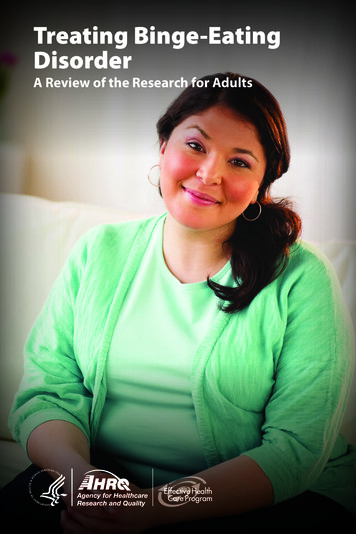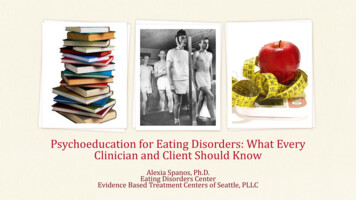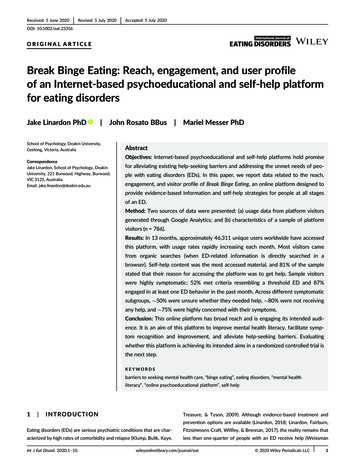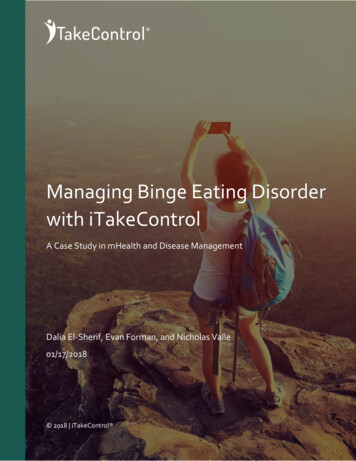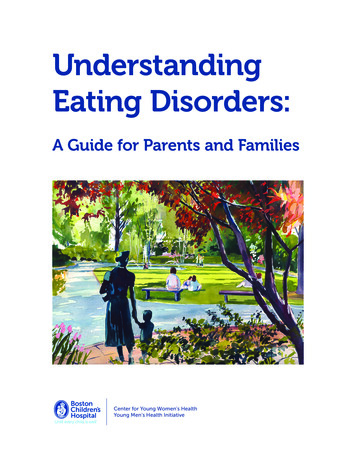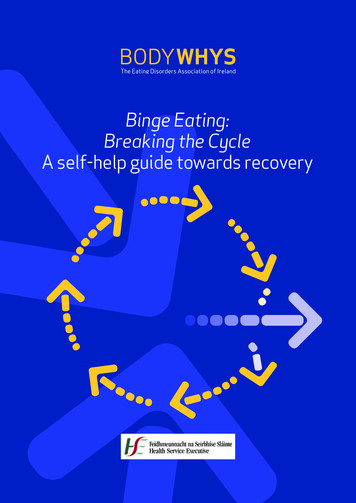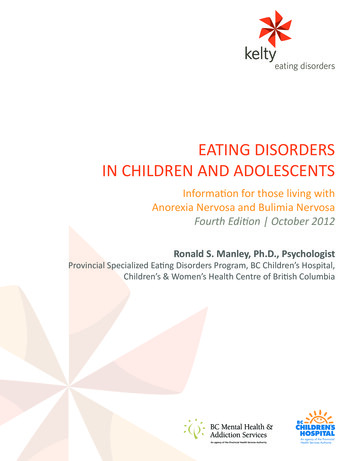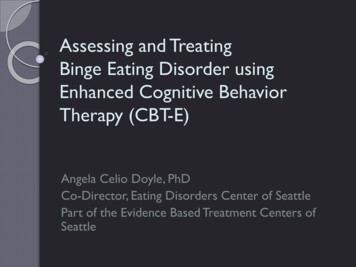
Transcription
Assessing and TreatingBinge Eating Disorder usingEnhanced Cognitive BehaviorTherapy (CBT-E)Angela Celio Doyle, PhDCo-Director, Eating Disorders Center of SeattlePart of the Evidence Based Treatment Centers ofSeattle
OverviewBriefly describe BED and assessment ofBED Introduce the basics of providing CBT-E Special considerations for co-morbiditieswhen using CBT-E
Binge Eating Disorder (BED) Inclusion in DSM 5Affects 16 out of every 1000 women in any12 month period 8 out of 1000 for men Lifetime prevalence: 35 out of 1000 women,20 out of 1000 men Weight-control programs ( 30%) All SES levels All ethnicities
DSM 5 Criteria Recurrent episodes of binge eating Eating, in discrete period of time (e.g., within any 2-hour period), an amount offood that is definitely larger than what most people would eat in a similar periodof time under similar circumstances. A sense of lack of control over eating during the episode (e.g., a feeling that onecannot stop eating or control what or how much one is eating). Episodes associated with 3 (or more) of the following: Eating much more rapidly than normal Eating until uncomfortably full Eating large amounts of food when not feeling physically hungry Eating alone because feeling embarrassed by how much one is eating Feeling disgusted with oneself, depressed, or very guilty after overeating Marked distress regarding binge eating Binge eating occurs, on average, at least once a week for 3 months Absence of regular compensatory behaviors (such as purging)
Co-occurring conditions Health conditions include obesity, type IIdiabetes, hypertension, gastric problems Associations between BE and weight gain, increasedhealth care utilization Psychiatric comorbidities in 78.9%* Any anxiety disorder: 65% Any mood disorder: 46% Any substance use disorder: 23%*Hudson, Hiripi, Pope, & Kessler, BiolPsychiatry, 2007
Assessment of BEDInterview Eating Disorder Examination (EDE)
Assessment of BED Binge Eating Scale Quick to administer Good sensitivity and specificity Eating Disorder Examination Questionnaire(EDEQ) Norms available, measures weight/shapeconcerns, dietary restraint, and eating concerns Clinical Impairment Assessment (CIA) Measures severity of impairment and “caseness”
Treatment Most efficacious treatments: Cognitive behavioral therapy (CBT) CBT-E Interpersonal psychotherapy (IPT) DBT? Integrative Cognitive-Affective Therapy(ICAT)? Uncertain role of SSRIs, topiramate,Vyvanse, other meds Very inconsistent results and no long termfollow up
Enhanced Cognitive BehaviorTherapy (CBT-E)Thoughts and behaviors maintain eatingdisorder Address these mechanism and eatingdisorder “falls like a house of cards” Can be used for any eating disorder individualized Manualized
Transdiagnostic CBT formulationOverevaluation of shape and weightand their controlStrict dieting;non-compensatoryweight-control behaviorEvents andassociated moodchangeBinge eatingSignificantly rn, Cognitive Behavior Therapyand Eating Disorders, 2008
Frequently mentioned resources Cognitive Behavior Therapy and Eating Disordersby Dr. Christopher G. Fairburn (2009) Centre for Research on Eating Disorders atOxford (CREDO): www.credo-oxford.com Overcoming Binge Eating: The Proven Program toLearn Why You Binge and How You Can Stop byDr. Christopher G. Fairburn (2013)
Fairburn, 2008
Goals of each stageStage 1: Gain mutual understanding of theED and to stabilize pattern of eating(twice weekly appts) Stage 2: Progress reviewed and plansmade for main body of treatment, stage 3 Stage 3: Addressing maintaining factors,including shape concerns, dailyevents/moods as triggers, dietary restraint Stage 4: Relapse prevention
Focused form versus Broad formFocused CBT-E limits itself to eatingdisorder-specific problems Broad CBT-E adds on modules to addressbroader issues of: Clinical perfectionism Core low self-esteem Interpersonal problems Decide in Stage 2
Overview of CBT-E for BED 20 50-minute sessions over 20 weeks 8 sessions over the first 4 weeksAim is not to keep treating until patient iscompletely asymptomatic, but mainmaintaining mechanisms have beendisrupted A review session is held a bit aftertreatment has ended
Stage 1 of CBT-ESessions 0-7, twice/week Goals: Engage patient in treatmentJointly create personalized formulationProvide relevant educationIntroduce two potent CBT-E procedures: In-session weighing Regular eating
Session 0Tasks: Engage patient in treatment Assess BED Jointly create formulation Explain what treatment will involve Introduce self-monitoring Confirm homework assignments Summarize and arrange next appt
Session 0Tasks: Engage patient in treatment Assess BED Jointly create formulation Explain what treatment will involve Introduce self-monitoring Confirm homework assignments Summarize and arrange next appt
CBT formulation for all EDOverevaluation of shape and weightand their controlStrict dieting;non-compensatoryweight-control behaviorEvents andassociated moodchangeBinge ntly lowweight
CBT formulation for BEDOverevaluation of shape and weightand their controlStrict dieting;non-compensatoryweight-control behaviorEvents andassociated moodchangeBinge eating
CBT formulation for BED
Case example: Helen55 year old woman Lifetime history of BED (binge eatingsince 15 years old, ebbs and flows) Binge eating 5-7 times/week Lives with her husband and twoelementary-aged children Very educated and skilled physician, buttaking time off to raise kids
CBT formulation for BED: HelenStaying up until 2 or3am binge eating whilewatching TV anythingthat’s in the kitchen
CBT formulation for BED: HelenTrying new diets all of thetime: anti-inflammation, lowcarb, cleanses, etc .Staying up until 2 or3am binge eating whilewatching TV anythingthat’s in the kitchen
CBT formulation for BED: HelenWeight as key part of identity since achild and in comparison with slendersiblingsTrying new diets all of thetime: anti-inflammation, lowcarb, cleanses, etc .Staying up until 2 or3am binge eating whilewatching TV anythingthat’s in the kitchen
CBT formulation for BED: HelenWeight as key part of identity since achild and in comparison with slendersiblingsTrying new diets all of thetime: anti-inflammation, lowcarb, cleanses, etc .Feeling overcommitted, overburdened, guiltyStaying up until 2 or3am binge eating whilewatching TV anythingthat’s in the kitchen
Self-monitoringCentral to treatment Rationale: Need to be able to seemoment-to-moment detail of the processof the eating disorder and need to worktogether to identify what can change Address common concerns
Instructions for self-monitoringCarry forms with you Record as soon as possible after you eator drink and be complete in yourrecording Calories and detailed quantity notincluded
Session 1Tasks: Initiate in-session weighing Reviewing self-monitoring Reviewing formulation Education about weight-checking andweight
Session 1Tasks: Initiate in-session weighing Reviewing self-monitoring Reviewing formulation Education about weight-checking andweight
Session 1: In-session weighingCollaboratively done to move patientaway from over-checking or avoidingweight Dispels possible myths about what ishappening with weight Taught how to regard weight and changes:“one cannot interpret a single reading”
Session 1Tasks: Initiate in-session weighing Reviewing self-monitoring Reviewing formulation Education about weight-checking andweight
Session 1: Education about weightchecking and weight Weight fluctuates throughout dayFrequent weighing leads to preoccupationwith unmeaningful changes in weightWeight changes tend to be used to supportidea that the person should dietInstead, the goal weight should be the weightthat you are when you are not binge eating; If weight loss is eventually a goal, the secondweight range will be based on what your weightis when exercising regularly and eating in abalanced, moderate fashion
Remainder of Stage 1 (sessions 2-7)Standard structure: In session weighing and interpretation(once/week) [up to 5 minutes] Review latest monitoring records and anyhomework assignments [up to 10 minutes] Collaborative agenda-setting [3 minutes] Working through agenda and agreeing onhomework [up to 30 minutes] Summarize session, confirm homework,arrange next appointment [3 minutes]
Remainder of Stage 1 Education on eating disorders Guided reading from Overcoming BingeEating (Chapters 1, 4, 5 in particular) Review of topics by therapist (Table 6.1)Establishing regular eating Involving significant others
Remainder of Stage 1 Education on eating disorders Guided reading from Overcoming BingeEating (Chapters 1, 4, 5 in particular) Review of topics by therapist (Table 6.1)Establishing regular eating Involving significant others
Remainder of Stage 1:Regular Eating“It is now time to begin making changes to youreating. The first one simply concerns when youeat, not what you eat. It has been found thateating at regular intervals throughout the dayreally helps people with eating problems. Doingthis, and doing it well, is really important. It is thefoundation upon which all other changes will bebuilt.”Fairburn, 2008, pg 77
Regular Eating1) Patients should eat 3 meals and 2planned snacks each day: BreakfastLunchMid-afternoon snackDinnerEvening snack2) Patients’ eating should be confined tothose meals and planned snacks
Regular eatingTips for “meal hygiene”: Meals should have clear beginning and end Meals should be taken sitting down andnot while being distracted by TV orreading Slowed down, deliberate
Remainder of Stage 1:Involving significant others (SOs)* * SO sessions are 45 minutes and are added onto a usual 50 minute session Review treatment and discuss ways SO can behelpful, e.g., responding to requests for helpwhen having difficulty resisting eating betweenmeals/snacks
Stage 2 (sessions 8-9)Only 2 sessions, held weekly Review progress EDE-Q, CIADiscuss what is getting in the way usingreview of treatment elements Update the formulation Decide whether to use broad version ofCBT-E
Stage 2 (sessions 8-9)Plan Stage 3, the main body of thetreatment Key maintaining mechanisms identifiedand plans made for where to start Over-evaluation of shape and weight Dietary restraint Event- or mood-triggered changes in eating
Stage 3 (sessions 10-17) Concerns about weight and shape: Enhancing importance of other domains forself-evaluation Addressing body-checking and avoidance Addressing “feeling fat”
Stage 3 (sessions 10-17) Concerns about weight and shape: Enhancing importance of other domains forself-evaluation Addressing body-checking and avoidance Addressing “feeling fat”
“Risky” self-esteem pie chartS hape, weight andeatingF amilyWorkO ther
Diverse self-esteem pie chartS hape, weight andeatingF amilyWorkF riendsS portsV olunteeringM us icC raftingO ther
Stage 3 (sessions 10-17) Dietary restraint Leads to binge eating through psychologicalmechanisms rather than physical ones Break a rule – “to hell with it!” bingeReduce rigid food rules Work on including “forbidden foods”
Stage 3 (sessions 10-17) Events, moods and eating Overeating as a “treat” or reward Binge eating can distract from negative eventsor moods and has a direct dampening ofintense mood states1)2)Proactive problem-solving to addresstriggering eventsStrategies for mood modulation
Example: HelenTriggering events: criticism by husband,uncooperative kids at bedtime, nanny notcompleting job Moods: resentful, conflicted, guilty,ashamed Problem-solving Mood modulation
Stage 4: Ending wellSessions 18-20, every two weeks Cease self-monitoring Practicing “driving” on own for 20 weeksuntil follow-up session Short term maintenance plan At follow-up session 20 weeks aftersession 20, long-term maintenance plan isdeveloped
Broad form of CBT-EPerfectionism Low self-esteem Interpersonal difficulties
Broad form of CBT-EPerfectionism Low self-esteem Interpersonal difficulties
Core low self-esteemLongstanding and pervasive negative viewof the self Unconditional Cognitive therapy to identify distortionsin thinking and challenge these thoughts Improve interpersonal functioning -using Interpersonal Psychotherapy (IPT)
Co-morbidities in BEDMost often depression, anxiety, substancemisuse Questions to ask: Are the symptoms directly attributable to theED? If so, may just be feature of the BED Will symptoms likely interfere withtreatment? If so, need to be addressed beforeor at same time as CBT-E Are symptoms likely to dissipate once BED istreated? If so, probably do not need directinterventionFrom Fairburn, 2008
Difficulty of depressionInterfering symptoms: Hopelessness, lowdrive, difficulty concentrating Treat depression first – medication? Other mood disorders – with bipolar Iand II, treatment can proceed if mood isstable
Difficulty of anxietyLess likely to interfere with CBT-E Need to differentially diagnose – socialanxiety or discomfort with eating aroundothers due to shame? Agoraphobia could interfere Anxiety disorders most often existindependently rather than interact in BED,so can be treated separately in whateverorder
Difficulty of substance misuseDisinhibition from substances in thecontext of binge eating can interfere withtreatment Some patients able to reduce their use ofsubstances in order to work on BED If they are not able to readily controlsubstance use, specialist help to controlsubstances before CBT-E is recommended
Difficulty of obesity Clear definition of treatment goalsneeded Weight loss? Addressing binge eating first?
Thank you!Contact information:Angela Celio Doyle, PhDCo-Director, Eating Disorders CenterEvidence Based Treatment Centers of Seattle1200 5th Avenue, Suite 800Seattle, WA 98101(206) 374-0109adoyle@ebtseattle.com
Binge Eating Disorder (BED) Inclusion in DSM 5 Affects 16 out of every 1000 women in any 12 month period 8 out of 1000 for men Lifetime prevalence: 35 out of 1000 women, 20 out of 1000 men Weigh
